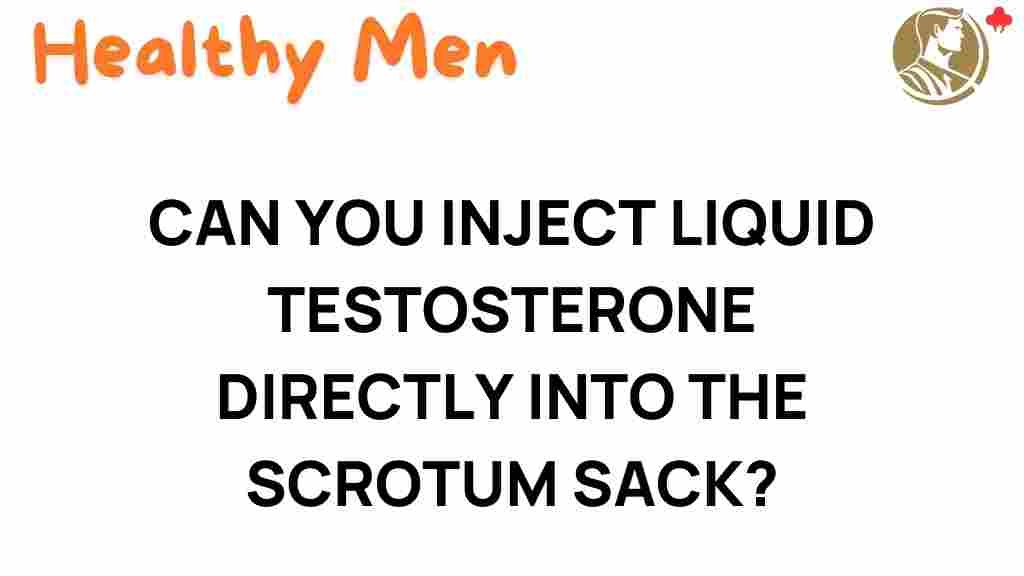The Controversial Practice of Injecting Testosterone: Is the Scrotum a Viable Option?
Testosterone injection has become a popular method in hormone therapy for men dealing with low testosterone levels. While traditional injection sites are commonly used, the idea of injecting testosterone into the scrotum is gaining attention. This practice raises numerous questions about its viability, safety, and effectiveness. In this article, we will explore the controversial practice of scrotal testosterone injections, examining its implications for men’s health, associated safety concerns, and alternative methods available for testosterone therapy.
Understanding Testosterone and Its Importance
Testosterone is a vital hormone primarily produced in the testicles in men. It plays a crucial role in various bodily functions, including:
- Regulating sex drive (libido)
- Maintaining muscle mass and strength
- Supporting bone density
- Contributing to mood regulation
- Facilitating the production of red blood cells
Men with low testosterone levels may experience a range of symptoms, such as fatigue, depression, decreased libido, and muscle weakness. Hormone therapy, particularly testosterone injections, has been prescribed to alleviate these issues.
Testosterone Injection: Common Methods
Testosterone injections are typically administered in several ways:
- Intramuscular Injections: These involve injecting testosterone into large muscle groups, such as the thigh or buttock.
- Subcutaneous Injections: This method involves injecting testosterone into the fatty tissue just beneath the skin, often in the abdomen or thigh.
- Scrotal Injections: The more controversial method where testosterone is injected directly into the scrotum.
The Scrotum as an Injection Site: How It Works
Injecting testosterone into the scrotum is thought to be beneficial due to the unique blood supply and local absorption characteristics of the scrotal tissue. This method allows for:
- Rapid absorption into the bloodstream
- Potentially lower doses required for the same effect
- Minimized fluctuations in testosterone levels
However, this practice is not widely endorsed by the medical community, leading to significant debate over its safety and efficacy.
Safety Concerns Surrounding Scrotal Testosterone Injections
While some proponents argue for the benefits of scrotal testosterone injections, there are several safety concerns to consider, including:
- Risk of Infection: Any injection carries a risk of infection, and the scrotum is a sensitive area.
- Pain and Discomfort: Many individuals report discomfort during and after the injection.
- Potential for Hormonal Imbalance: Improper dosing can lead to excessive levels of testosterone, causing side effects such as mood swings, acne, and increased risk of cardiovascular issues.
- Long-term Effects: There is limited research on the long-term effects of scrotal injections, raising concerns about potential unknown risks.
Consulting with a Healthcare Provider
Before considering testosterone injections, particularly in the scrotum, it is essential to consult with a healthcare provider. They can evaluate your testosterone levels through blood tests and discuss suitable treatment options tailored to your needs. It’s crucial to weigh the benefits against the risks and to explore all available alternatives.
Alternative Methods of Testosterone Replacement Therapy
If scrotal testosterone injections do not seem viable, there are several alternative methods for testosterone replacement therapy:
- Topical Gels and Creams: Applied daily to the skin, these products allow testosterone to be absorbed transdermally.
- Patches: These adhesive patches deliver testosterone through the skin over a 24-hour period.
- Pellets: Small pellets can be implanted under the skin, releasing testosterone over several months.
- Oral Medications: Some testosterone formulations are available in pill form, though they may carry a higher risk of liver issues.
Each of these alternatives has its own set of benefits and drawbacks, and a healthcare provider can help navigate which is most appropriate for individual circumstances.
Step-by-Step Process for Testosterone Injection
If you decide to proceed with testosterone injections, here’s a general outline of the process:
- Consultation: Meet with your doctor to discuss your symptoms and get a prescription.
- Preparation: Gather supplies, including the testosterone vial, syringes, alcohol swabs, and bandages.
- Cleaning: Clean the injection site with an alcohol swab to minimize infection risk.
- Drawing the Testosterone: Use the syringe to draw the prescribed amount of testosterone from the vial.
- Injecting: Inject the testosterone into the designated area (follow your doctor’s instructions for scrotal injections).
- Post-Injection Care: Apply pressure to the injection site with a cotton ball or bandage.
Troubleshooting Common Issues
Here are some common issues you may encounter with testosterone injections and tips on how to address them:
- Pain at the Injection Site: Ensure you are using a proper technique and injecting into the correct area. Applying ice before the injection may help numb the site.
- Infection Signs: Watch for redness, swelling, or pus. If these occur, contact your healthcare provider immediately.
- Fluctuating Testosterone Levels: Discuss with your doctor if you experience mood swings or other symptoms suggesting hormonal imbalance. Adjustments to your dosage or injection frequency may be necessary.
Conclusion: Weighing the Options
The practice of injecting testosterone into the scrotum is controversial and requires careful consideration. While there may be potential benefits, the associated risks and lack of extensive research warrant caution. It is essential to prioritize safety and consult with healthcare professionals about the best methods for managing low testosterone levels.
For those exploring testosterone therapy, understanding all available options, including the pros and cons of scrotal injections and alternative methods, is vital for making informed decisions about men’s health. Remember that maintaining healthy testosterone levels is crucial for overall well-being, and there are numerous paths to achieve this goal.
For more information on hormone therapy and men’s health, you can read our comprehensive guide. Additionally, for further scientific insights, check out this external resource on testosterone therapy and safety.
This article is in the category Conditions and created by healthymen Team
